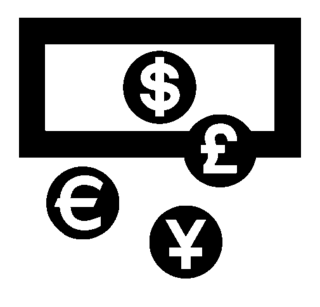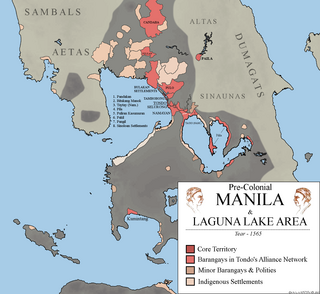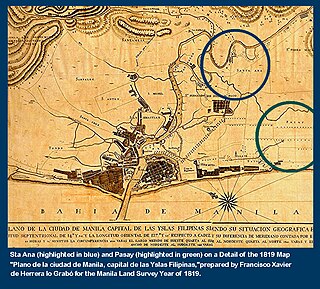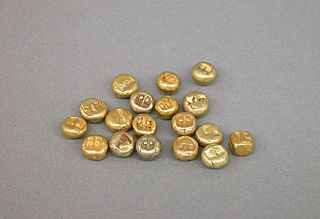
A coin is a small, flat, round piece of metal or plastic used primarily as a medium of exchange or legal tender. They are standardized in weight, and produced in large quantities at a mint in order to facilitate trade. They are most often issued by a government. Coins often have images, numerals, or text on them. Obverse and its opposite, reverse, refer to the two flat faces of coins and medals. In this usage, obverse means the front face of the object and reverse means the back face. The obverse of a coin is commonly called heads, because it often depicts the head of a prominent person, and the reverse tails.

Numismatics is the study or collection of currency, including coins, tokens, paper money, medals and related objects.

The Philippine peso, also referred to by its Filipino name piso, is the official currency of the Philippines. It is subdivided into 100 sentimo, also called centavos.

The Spanish dollar, also known as the piece of eight, is a silver coin of approximately 38 mm (1.5 in) diameter worth eight Spanish reales. It was minted in the Spanish Empire following a monetary reform in 1497 with content 25.563 g = 0.822 oz t fine silver. It was widely used as the first international currency because of its uniformity in standard and milling characteristics. Some countries countermarked the Spanish dollar so it could be used as their local currency.

A mint is an industrial facility which manufactures coins that can be used as currency.

A debasement of coinage is the practice of lowering the intrinsic value of coins, especially when used in connection with commodity money, such as gold or silver coins. A coin is said to be debased if the quantity of gold, silver, copper or nickel in the coin is reduced.

Philippine peso coins are issued by the Bangko Sentral ng Pilipinas for circulation in the Philippines and are currently available in seven denominations. The Philippine peso has been in use since Spanish rule.

The history of money concerns the development throughout time of systems that provide the functions of money. Such systems can be understood as means of trading wealth indirectly; not directly as with bartering. Money is a mechanism that facilitates this process.
The Philippine real was the currency of the Philippines during the Spanish Colonial Era. Brought over in large quantities by the Manila galleons, eight silver reales made up a silver peso or a dollar. 16 silver real were equal to one gold escudo.

Piloncitos are small "bead-like" pieces of gold which were used as currency during the Philippines' Archaic period and in the earliest years of the country's Spanish colonial period. These gold pieces have been excavated from sites throughout the Philippine archipelago: Mandaluyong, Bataan, the banks of the Pasig River, Batangas, and Marinduque in Luzon; Samar and Leyte in the Visayas; and in some areas in Mindanao.

In early Philippine history, the Tagalog settlement at Tondo was a major trade hub located on the northern part of the Pasig River delta, on Luzon island.

Namayan, also called Sapa, Maysapan or Nasapan, and sometimes Lamayan, was an independent indigenous polity on the banks of the Pasig River in the Philippines which is believed to have achieved its peak in 1175.
Bernard von NotHaus is the creator of the Liberty Dollar and co-founder of the Royal Hawaiian Mint Company, in Hawaii. He is also the founder of the Cannabis Spiritual Center, an educational institution that supports the use of marijuana in spiritual settings. Von NotHaus was convicted of counterfeiting in 2011, and was even accused of domestic terrorism. He was sentenced to three years of probation, and was released from probation after serving one year.
Italy has a long history of different coinage types, which spans thousands of years. Italy has been influential at a coinage point of view: the florin, one of the most used coinage types in European history, was struck in Florence in the 13th century. Since Italy has been for centuries divided into many city-states, they all had different coinage systems, but when the country became unified in 1861, the Italian lira came into place, and was used until 2002. Today, Italy uses the Euro.

Chinese coinage in the Ming dynasty saw the production of many types of coins. During the Ming dynasty of China, the national economy was developed and its techniques of producing coinage were advanced. One early period example is the Bronze 1 cash. Obverse: "Hongwu Tongbao" (洪武通寶). Reverse: blank. Average 23.8 mm, 3.50 grams.

The history of Philippine money covers currency in use before the Hispanic era with gold Piloncitos and other commodities in circulation, as well as the adoption of the peso during the Hispanic era and afterwards.

The archaeology of the Philippines is the study of past societies in the territory of the modern Republic of the Philippines, an island country in Southeast Asia, through material culture.

By the 10th-century, Java had one of the most complex economies in Southeast Asia. Despite the importance of rice farming which acts as the chief tax income for the Javanese courts, the influx of sea trade in Asia between the 10th and 13th centuries forced a more convenient currency to the Javanese economy. During the late 8th-century, ingots made of gold and silver were introduced. These are the early Nusantara coins.

The extensive use of gold during early Philippine history is well-documented, both in the archeological record and in the various written accounts from precolonial and early Spanish colonial times. Gold was used throughout the Philippine archipelago in various decorative and ceremonial items, as clothing, and also as currency.














